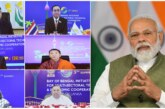India is already faced with water crisis. The falling underground water tables, particularly in the states of Haryana, Punjab, Rajasthan, western Uttar Pradesh and Delhi are a cause of serious concern. According to a recent report published in the journal Nature by Matthew Rodell and Jay Famiglietti, based on American NASA’s Gravity Recovery and Climate Experiment (GRACE) data between August 2002 and October 2008, groundwater stocks in these states are being lowered at an average rate of about 4 centimeters (1.6 inches) a year. The depletion is equal to about 17.7 cubic kilometers (4.7 trillion gallons) of water a year, exceeding the estimate of 13.2 cubic kilometers by India’s Ministry of Water Resources.
India’s area of irrigation almost tripled to 33.1 million hectares (82 million acres) from 1970 to 1999, the authors said, spurred by the so-called Green Revolution that began in the 1960s to bolster production of wheat, rice and other staples.
While suggesting that pumping water from wells for irrigation is damaging India’s resources more than the government has estimated, this study laments that without measures to curb demand, dwindling groundwater supplies may cause drinking-water shortages and erode crop production in for these states inhabited by 114 million people.
According to Jay Famiglietti, co-author of this study, these states are “really experiencing rapid groundwater decline that’s mostly human-driven. What they are doing is not sustainable.” According to the Stockholm International Water Institute, about a fifth of water used globally comes from under the ground. Withdrawals are predicted to increase 50 per cent by 2025 in developing countries, and 18 percent in developed countries.
The authors of the report warn that if measures are not taken to ensure sustainable groundwater usage, the consequences for the 114 million residents of the region may include a collapse of agricultural output and severe shortages of potable water. It is noteworthy that this alarming trend came in years where there was no shortage of rainfall. The recently released report of India’s Ministry of Environment has also warned that a growing percentage of its groundwater was neither drinkable nor could be used for irrigation. ‘This illustrates that degraded water quality can contribute to water scarcity as it limits its availability for both human use and the ecosystem.
Such a grim picture emerging from these and other related reports point out that much of the water crisis is man-made because of lack of proper governance of water resources. Although there is only about 3 per cent of fresh water available throughout the globe which is fit for human consumption but even then nature has bestowed this rare commodity for human consumption in plenty if it is properly utilized. Proper governance of water resources by some countries like Singapore and Japan has demonstrated that the problem of water scarcity can be met through good governance, harnessing technology, efficient bureaucracy, strong political will, public-private partnership and allowing the civil society’s role in managing water sector especially at the grassroots level. To prove our point we are giving below brief appraisal about water management in Singapore, Japan and Cambodia.
Water Management in Singapore
Water is fast emerging as an issue of national security for most of the developing countries and Singapore is one of them because of its dependence on imports of water from neighbouring Malaysia. Singapore is a city-state having an area about 700 sq km and a population of about 4.4 million. Providing clean water to its population, which currently consumes 1.36 billion litres of water per day has been one of the main concerns of the government of Singapore. Singapore is regarded as a water-scarce country not on account of paucity of rainfall which is about 2400 mm/year, but owing to limited amount of land area available where the rainfall can be stored.
In order to meet its water requirements, Singapore imports water from the neighbouring Malaysia through three large pipelines. In order to reduce its import dependency of water, the Government of Singapore has devised a plan for augmenting water security and self-sufficiency during the post-2011-period, with increasing emphasis on more efficient water management, including the formulation and implementation of new water-related policies, heavy investments in desalination and extensive reuse of wastewater, and catchment management and other similar measures. The entire water cycle of Singapore is looked after by the Public Utilities Board (PUB).
Singapore’s success in managing its water and wastewater resources is attributed to its concurrent emphasis on supply and demand management, wastewater and storm-water management, institutional effectiveness and creating a congenial environment, which includes a strong political will, effective legal and regulatory mechanism, and an experienced and motivated workforce.
Supply Management
It is interesting to note that Singapore looks at its supply sources in their totality. Apart from importing water from neighbouring Malaysia, the Government of Singapore has made determined effort to safeguard its water sources, both in terms of quality and quantity on a long-term basis, expanding its available sources by desalination and reuse of wastewater and storm-water, harnessing technological developments to augment water availability, improving water quality management and reducing production and management costs. The PUB’s in-house Centre for Advanced Water Technology provides necessary technical and development support.
Singapore Government places increasing emphasis on catchment management. Protected catchment areas are well demarcated and notified where no pollution-causing activities are allowed. It is worth mentioning here that Singapore has attained enviable success in recycling wastewater. The quality of recycled water meets the water quality standards of the Environmental Protection Agency of the United States and the World Health Organization (WHO). The recycled water being more pure than tap water is used in strategic manufacturing industries like semiconductors which require ultra pure water. The recycled water is expected to meet 15 per cent of Singapore’s water needs by 2011.
Demand Management
Singapore’s Public Utilities Board has worked out a well-concerted and comprehensive demand policy by rationalizing the water conservation tax (WCT) and water-borne fee (WBF) which have a notable impact on the behaviour of the consumers, and has turned out to be an effective instrument for demand management. In terms of equity, the Singapore Government provides ‘specially targeted help’ for lower income families which receive higher rebates during difficult times.
Overall Water Governance
Many observes feel that Singapore’s overall governance of the water supply and wastewater management systems is exemplary in terms of its performance, transparency and accountability. The PUB has overcome constraints like political interference, poor management, overstaffing and career stagnation through a competitive remuneration, incentives and benefits package. PUB’s pro-family policies, commitment to train its personnel for their professional and personal development, and rewarding good performers have been instrumental in ensuring good organizational performance and development.
In order to keep PUB free from the malaise of corruption, emphasis is laid on staff training on Code of Governance and Code of Conduct, effective internal control processes, regular audits and strong and immediate sanctions against those who may prove to be corrupt. Besides, staff members are required to make annual declarations which include Declaration of Assets, and Investments and Declaration of Non-Indebtedness.
In contrast to many water governance organizations in other countries, the PUB enjoys relative autonomy coupled with solid political and public support. This has enabled the PUB to increase water tariffs in progressive steps thereby resulting in reduced household water demand and increase in the revenues of the PUB.
The PUB has been able to launch many innovative approaches to manage the total water cycle in Singapore and undeniably these approaches can be emulated by developed and developing countries to improve their water governance systems.
Water Management in Japan
In recent years Japan has been able to develop an additional annual volume of 16.6 billion m3 of water resources by constructing new dams. The national and local governments pay most of the construction costs. Currently, about 55% of total water consumption for domestic and industrial use depends on these newly developed water resources.
Water is allocated in a variety of ways. Local governments allocate river water rights for urban and industrial use to public water utilities in each region. Moreover, the Industrial Water Law and the Law for Ground Water Use in Buildings regulate ground water abstraction. These laws require permits from local governments to withdraw ground water in certain designated areas where serious land subsidence is a threat or where ground water resources are scarce.
Environmental Quality Standards, along with water quality monitoring systems and effluent regulations, have worked well to protect the overall quality of water resources. Various demand-control measures have also been implemented using both market-based instruments and regulations. For example, most public water utilities introduced incentive-based-pricing schemes such as increasing-block charges and differential user charges. As a result, water scarcity problems have decreased over time along with the gradual improvement of drinking water quality.
The increasing demands on Japan’s fresh water resources due to economic and population growth in recent decades have been instrumental in spurring the development of water resources in Japan. Problems of both the quantity of available water and its quality had to be addressed. Although the administrative structure is particular to Japan, there are certain broader lessons that the Japanese experience offers to other countries facing similar challenges.
A major theme in the Japanese case is the “partnership” element between national authorities and local-level utilities and governments. The overall framework for water resources development is set by the national government while actual implementation and management is largely left to the local level. This places implementation close to the ultimate beneficiaries, and strengthens the link between those providing the service and those using the service. Local utilities have tended to be monopolies, however, and have relied heavily on subsidies to keep prices down and avoid the “market test” of competition and full-cost pricing of their product.
A recent development in Japan has been the increasing use of private sector to provide specific services to local water utilities (or, in some cases, to actually manage them on behalf of the local authorities).
Another trend in Japan has been the consolidation of many small water service providers into larger aggregates. This enables the larger firms to take advantage of “economies of scale” and try to keep costs down.
The one dimension of Japanese water resources development that is not as transferable to many other countries is the very large role of government subsidies at all levels. Construction costs are heavily subsidized by the national government (with an appropriate sliding scale of higher subsidies for agricultural uses, sewage treatment and waste water collection, and lower subsidies for domestic water supply and industrial water supply). The level of subsidies reflects both the ability and willingness-to-pay of the water users, as well as the public goods nature of certain services (such as wastewater treatment).
However, in Japan there are also substantial subsidies for management at the local utility level. These result in lower water prices to almost all users, and the subsidies both create continuing budgetary drains, but also do not encourage water conservation. The utilities lose some of the “edge” that comes from having to pay most of (part of) their operating costs, and consumers view water as a “cheaper’ commodity than it really is.
Since market prices do not send full information on the costs of supplying water, Japan has tried a number of different policy measures to encourage conservation and promote better efficiency of water use. These include both traditional command-and-control measures (especially important for pollution control problems) as well as various economic–based measures. Japan has used both types of measures extensively, and, especially with the economic measures, has a system in place to generate revenues to help pay for water systems operation and management (although the large role of subsidies makes water relatively “cheaper” than it would otherwise be).
A new policy tool being tried in Japan is a “resource management tax”—designed to raise revenues to manage either forested watersheds or groundwater resources—whereby water users pay a small tax to help better manage ecosystems that are the ultimate source of the water supplies. Although the taxes are small at present, the principle of payment for ecosystem services is being gradually introduced.
Water Management in Cambodia
Cambodia is located on the lower side of Mekong River which constitutes the major its source of water. In recent years, the Government has progressed steadily in establishing a legal and policy framework for the water sector. The National Water Resources Policy was approved in early 2004. The Law on Water Resources Management was approved in 2005. Draft regulations have been prepared for (i) river basin management and planning, and (ii) water allocation and basin management.
The legal and policy framework promotes sustainable water resources planning and management in a river basin context. Through the adoption of integrated water resources management (IWRM), water will be used to achieve the greatest net economic and social benefit. IWRM aims to prevent conflict and competition by creating an environment conducive to satisfying present and foreseeable demands. However, the policy has yet to be fully implemented and further resources and institutional capacity building are needed.
Since 1996, the Government of Cambodia has been implementing a programme of decentralization and de-concentration that promotes increased local-government and community involvement in natural resources planning and management.
Decentralization process is being applied at provincial level within the environmental sector. The related works of water environmental pollution control/monitor are implemented by the Ministry of Environment. There is a provision for monthly freshwater monitoring at designated water bodies through sampling points. It also facilitates routine control/monitoring at pollution sources and evaluating the environmental pollution level.
Apart from decentralization, public-private partnership in water sector and increasing role of the non-governmental organizations (NGOs) are the new upcoming features of water management in Cambodia. However, constraints like paucity of financial resources, shortage of experts on water, pollution control and environment coupled with the fact of media’s apathy have limited the scope of reforms in water governance in Cambodia.
Lessons for India
India has to learn a lot from Singapore and Japan in the field of water governance. Singapore’s management of water resources by its PUB has definitely set an international exemplary standard worth emulating even by some of the developed countries. The relative autonomy, decentralization, human resource policies, particularly in dealing with corruption are of particular relevance for India. Similarly, Japan model of high subsidies by the central government in water-related plans, public-private partnership in water sector are of specific interest to India.
Though Cambodian model does not offer much for India to emulate its water governance mechanism, but still its emphasis on decentralization and involvement of the civil society in managing water resources at local levels is notable and can be emulated by India. Emulating Singapore and Japanese model by India can certainly be helpful in meeting the water-related problems in the country to a large extent.
By Dr. Arvind Kumar President India Water Foundation



